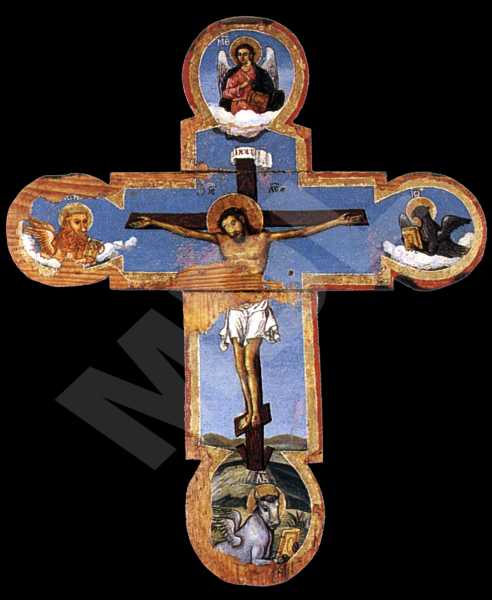Supraiconostasic Crucifix
Type:
Plastic iconographical object:
Cross
Period:
The first half of the
19 century
Dimiter T. Molerov, born in 1780 in Bansko, son of Toma Vishanov the Moler. One of the best-known painters, a representative of the Bansko school of art, a disciple of his father, influenced by the art of Athos. Author of the murals of the naos in the St Archangels' paraclete in the Rila monastery, the murals in the Church of the Assumption of the Virgin in the Pchelino dependance. In 1840 and 1841 together with his son Simeon Molerov he paints the murals and the sponsors' portraits in St. Nicholas' and St. John of Rila's paracletes in the principal church in the Rila monastery. Among D. Molerov's major achievements in iconography are the following icons: St. Nicholas (1816) from St. Archangel Michael's church in the village of Leshko, Christ All-triumphant with Angels and Cherubim (1833), The Nativity and a Crucifixion from St Elijah the Prophet's church in the village of Usenovo. He has also worked in Belgrade on an invitation by Prince Milosh Obrenovich of Serbia. He died in 1870 in Bansko.
Dimmensions (cm):
60
/ 50
/ 4
Location
Country: Bulgaria
Province: Montana
Town: Berkovitsa
Gallery: Art Gallery
Source
Country: Bulgaria
Other source: Others
Description
The iconography is a traditional one. In the center is the crucified Christ, and painted in the four ends of the cross are the symbols of the four evangelists.
Iconographical technique: Combined
The "wet into wet" method has also been made use of in the carnations. The varnish cover is applied thinly and evenly. There is some gilding only on the aureoles and along the enclosing frame.
Base material: Wood
The base is made of two softwood panels, fastened together by means of rabbet joint and nailed additionally with 4 nails. The ground coat is of a thin layer of plaster.
State, restoration traces and comments
There is a great amount of fallen-off painting layer, which makes difficult the perception of the composition. There are also traces of numerous mechanical damages in the area of the image of Christ. A professional restoration has been done, the painting layer having been stabilized and retouched.


